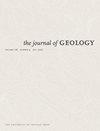Water Content and Deformation of the Lower Crust beneath the Siberian Craton: Evidence from Granulite Xenoliths
IF 1.3
4区 地球科学
Q2 GEOLOGY
引用次数: 2
Abstract
Water in the lower crust plays a critical role in rheological layering of the continental lithosphere. Sixteen granulite xenoliths were collected from the Late Devonian Udachnaya and Komsomolskaya kimberlites in the Siberian Craton. Mafic granulite samples experienced pressures of 0.6–1.0 GPa and temperatures of 549°–800°C using the Grt-Cpx (garnet-clinopyroxene) Fe-Mg thermometer, which are consistently lower than equilibrium temperatures of 737°–899°C from the REE-in-Grt-Cpx thermobarometer. Compared with pseudosection calculations, our samples experienced continuous cooling since the last granulite facies metamorphism. Moderate to high water content was measured in clinopyroxene (334–977 ppm H2O), garnet (23–149 ppm H2O), and plagioclase (157–779 ppm H2O), resulting in the bulk water content of 267–707 ppm H2O in granulite samples. Given the very limited later metasomatism and hydrogen loss, water content in granulite xenoliths probably represents in situ water-rich lower crust of the Siberian Craton from 1.8 Ga to the Late Devonian. Clinopyroxene and plagioclase show weak crystallographic preferred orientations, whereas garnet has random orientation. Compared with previous studies, the Precambrian lower crust in stable cratons contains comparable or less water than Phanerozoic lower crust in orogenic belts. Magma underplating in cratons can trigger partial melting of ancient water-rich granulites and produce heterogeneous water distribution in the lower crust.西伯利亚火山口下地壳的含水量和变形:来自麻粒岩捕虏体的证据
下地壳中的水在大陆岩石圈的流变分层中起着至关重要的作用。从西伯利亚克拉通的晚泥盆纪Udachnaya和Komsomolskaya金伯利岩中采集了16个麻粒岩捕虏体。使用Grt-Cpx(石榴石斜辉石)Fe-Mg温度计,镁铁质麻粒岩样品的压力为0.6–1.0 GPa,温度为549°–800°C,始终低于Grt-Cpx温度计中REE的平衡温度737°–899°C。与假剖面计算相比,我们的样品自上次麻粒岩相变质作用以来经历了持续冷却。在斜辉石(334–977 ppm H2O)、石榴石(23–149 ppm H2O)和斜长石(157–779 ppm H2O)中测得中等至高含水量,导致麻粒岩样品中的总含水量为267–707 ppm H2O。考虑到后期交代作用和氢损失非常有限,麻粒岩捕虏体中的含水量可能代表西伯利亚克拉通1.8Ga至晚泥盆纪的原位富水下地壳。斜辉石和斜长石显示出弱的结晶择优取向,而石榴石具有随机取向。与以往的研究相比,稳定克拉通中的前寒武纪下地壳的含水量与造山带中的显生宙下地壳相当或更少。克拉通中的岩浆底侵可引发古代富水麻粒岩的部分熔融,并在下地壳中产生不均匀的水分布。
本文章由计算机程序翻译,如有差异,请以英文原文为准。
求助全文
约1分钟内获得全文
求助全文
来源期刊

Journal of Geology
地学-地质学
CiteScore
3.50
自引率
5.60%
发文量
0
审稿时长
3 months
期刊介绍:
One of the oldest journals in geology, The Journal of Geology has since 1893 promoted the systematic philosophical and fundamental study of geology.
The Journal publishes original research across a broad range of subfields in geology, including geophysics, geochemistry, sedimentology, geomorphology, petrology, plate tectonics, volcanology, structural geology, mineralogy, and planetary sciences. Many of its articles have wide appeal for geologists, present research of topical relevance, and offer new geological insights through the application of innovative approaches and methods.
 求助内容:
求助内容: 应助结果提醒方式:
应助结果提醒方式:


